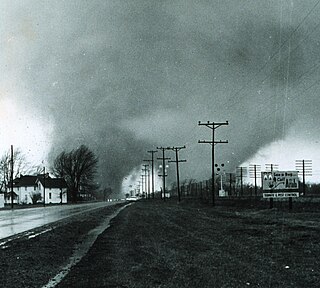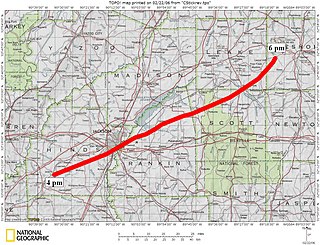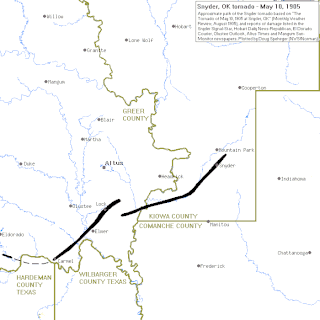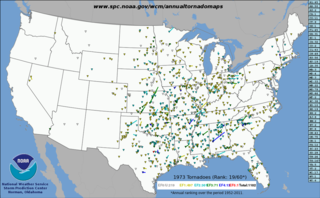Related Research Articles

On April 10–12, 1965, a historic severe weather event affected the Midwestern and Southeastern United States. The tornado outbreak produced 55 confirmed tornadoes in one day and 16 hours. The worst part of the outbreak occurred during the afternoon hours of April 11 into the overnight hours going into April 12. The second-largest tornado outbreak on record at the time, this deadly series of tornadoes, which became known as the 1965 Palm Sunday tornado outbreak, inflicted a swath of destruction from Cedar County, Iowa, to Cuyahoga County, Ohio, and a swath 450 miles long (724 km) from Kent County, Michigan, to Montgomery County, Indiana. The main part of the outbreak lasted 16 hours and 35 minutes and is among the most intense outbreaks, in terms of tornado strength, ever recorded, including at least four "double/twin funnel" tornadoes. In all, the outbreak killed 266 people, injured 3,662 others, and caused $1.217 billion in damage. In 2023, tornado expert Thomas P. Grazulis created the outbreak intensity score (OIS) as a way to rank various tornado outbreaks. The 1965 Palm Sunday tornado outbreak received an OIS of 238, making it the third worst tornado outbreak in recorded history.

The 1994 Palm Sunday tornado outbreak was the third notable US tornado outbreak to occur on Palm Sunday and the second to take place in the Southeastern United States. The outbreak produced 29 tornadoes from Texas to North Carolina, killing 40 people and injuring 491, and causing $140 million in damage. The deadliest storm of the outbreak, as well as in the US in 1994, was an F4 tornado that devastated Piedmont, Alabama. It struck the Goshen United Methodist Church right in the middle of the Palm Sunday service, collapsing the roof on the congregation and killing 20 people inside, including the Rev. Kelly Clem's 4-year-old daughter Hannah. Two other houses of worship were also destroyed mid-service. The supercell that formed this tornado tracked for 200 miles (322 km) to South Carolina.

The tornado outbreak of April 6–9, 1998 was a large tornado outbreak that started on April 6 across the Great Plains and ended on April 9 across the Carolinas and Georgia. A total of 62 tornadoes touched down from the Middle Atlantic States to the Midwestern United States and Texas. The outbreak is infamous for producing a deadly F5 that tore through the suburbs of Birmingham, Alabama, killing 32 people. The Birmingham tornado was one of only two F5 tornadoes that year. The other hit in Lawrence County, Tennessee, on April 16, as part of the same outbreak as the Nashville F3 tornado. This tornado outbreak was responsible for 41 deaths: 7 in Georgia and 34 in Alabama.

From April 2–3, 1956, a large, deadly tornado outbreak affected the Great Plains, parts of the South, and the upper Midwest in the contiguous United States, especially the Great Lakes region. The outbreak produced at least 55 tornadoes, including an F5 that devastated the Grand Rapids metropolitan area in the U.S. state of Michigan on April 3. It was one of three tornadoes to move across southwest Lower Michigan on that day. A fourth tornado struck north of the Manistee area, in the northern part of the peninsula. The Hudsonville–Standale tornado killed 18 and injured 333. It remains the fourth deadliest tornado on record in Michigan and is the most recent F5 on record there. Several other deadly, intense, long-tracked tornadoes also occurred during the outbreak. In addition to the fatalities in Kansas, Oklahoma, Michigan and Berlin, Wisconsin, three people were killed in Tennessee, one person in Kentucky and two more people in Wisconsin. In total, 39 were killed during the entire event.

A violent severe weather outbreak struck the Southeast on April 4–5, 1977. A total of 22 tornadoes touched down with the strongest ones occurring in Mississippi, Alabama, and Georgia. The strongest was a catastrophic F5 tornado that struck the northern Birmingham, Alabama, suburbs during the afternoon of Monday, April 4. In addition to this tornado, several other tornadoes were reported from the same system in the Midwest, Alabama, Georgia, Mississippi and North Carolina. One tornado in Floyd County, Georgia, killed one person, and another fatality was reported east of Birmingham in St. Clair County. In the end, the entire outbreak directly caused 24 deaths and 158 injuries. The storm system also caused the crash of Southern Airways Flight 242, which killed 72 and injured 22.

A destructive series of four tornadoes hit the Southeastern United States during March 3-4, 1966. The worst event was a violent and long-lived F5 tornado, dubbed the Candlestick Park tornado after the name of a recently opened Jackson, Mississippi shopping center that was leveled by the storm. The storm would bring catastrophic damage in Mississippi and Alabama along a 202.5-mile (325.9 km) track. The outbreak killed 58, injured 521, and caused $75.552 million in damage.

On December 16, 2000, a destructive tornado outbreak hit the Southeastern United States, from Mississippi to North Carolina. The most significant tornado of the outbreak occurred in communities south and east of Tuscaloosa, Alabama. The F4 tornado killed 11 people and injured more than 125 others; it was the strongest tornado to hit the state of Alabama in the month of December since 1950.
On April 23–25, 1908, a destructive tornado outbreak affected portions of the Midwestern and Southern United States, including the Great Plains. The outbreak produced at least 31 tornadoes in 13 states, with a total of at least 324 tornado-related deaths. Of these deaths, most were caused by three long-tracked, violent tornadoes—each rated F4 on the Fujita scale and considered to be a tornado family—that occurred on April 24. Most of the deaths were in rural areas, often consisted of African Americans, and consequently may have been undercounted. One of the tornadoes killed 143 people along its path, 73 of them in the U.S. state of Mississippi, making the tornado the third deadliest in Mississippi history, following the 1936 Tupelo F5, with 216 deaths, and the 1840 Natchez tornado, with 317 deaths.

The 1905 Snyder, Oklahoma, tornado was a powerful tornado that struck the town of Snyder, Oklahoma, in Kiowa County on Wednesday, May 10, 1905. The event was one of the worst natural disasters ever to hit the state of Oklahoma. The cyclone killed 97 people, making it the second most deadly tornado in Oklahoma history. The tornado was part of a larger, multiple-day tornado outbreak that hit several states across the Midwestern United States, including Kansas, Oklahoma, and Missouri.

On February 21–22, 1971, a devastating tornado outbreak, colloquially known as the Mississippi Delta outbreak, struck portions of the Lower Mississippi and Ohio River valleys in the Southern and Midwestern United States. The outbreak generated strong tornadoes from Texas to Ohio and North Carolina. The two-day severe weather episode produced at least 19 tornadoes, and probably several more, mostly brief events in rural areas; killed 123 people across three states; and wrecked entire communities in the state of Mississippi. The strongest tornado of the outbreak was an F5 that developed in Louisiana and crossed into Mississippi, killing 48 people, while the deadliest was an F4 that tracked across Mississippi and entered Tennessee, causing 58 fatalities in the former state. The former tornado remains the only F5 on record in Louisiana, while the latter is the deadliest on record in Mississippi since 1950. A deadly F4 also affected other parts of Mississippi, causing 13 more deaths. Other deadly tornadoes included a pair of F3s—one each in Mississippi and North Carolina, respectively—that collectively killed five people.
On March 21–22, 1932, a deadly tornado outbreak struck the Midwestern and Southern United States. At least 38 tornadoes—including 27 deadly tornadoes and several long-lived tornado families—struck the Deep South, killing more than 330 people and injuring 2,141. Tornadoes affected areas from Mississippi north to Illinois and east to South Carolina, but Alabama was hardest hit, with 268 fatalities; the outbreak is considered to be the deadliest ever in Alabama, and among the worst ever in the United States, trailing only the Tri-State tornado outbreak in 1925, with 751 fatalities, and the Tupelo–Gainesville outbreak in 1936, with 454 fatalities. The 1932 outbreak is believed to have produced 10 violent tornadoes, eight of which occurred in Alabama alone.
On April 19–21, 1920, a multi-day severe weather event affected the Southeastern United States. The most intense portion of the outbreak occurred on the morning of April 20. At least seven tornadoes affected the American U.S. states of Mississippi, Alabama, and Tennessee, six of them rated violent F4s on the Fujita scale. The tornado outbreak killed at least 243 people.
On December 18–20, 1957, a significant tornado outbreak sequence affected the southern Midwest and the South of the contiguous United States. The outbreak sequence began on the afternoon of December 18, when a low-pressure area approached the southern portions of Missouri and Illinois. Supercells developed and proceeded eastward at horizontal speeds of 40 to 45 miles per hour, yielding what was considered the most severe tornado outbreak in Illinois on record so late in the calendar year. Total losses in the state were estimated to fall within the range of $8–$10 million.

This page documents the tornadoes and tornado outbreaks of 1974, primarily in the United States. Most tornadoes form in the U.S., although some events may take place internationally. Tornado statistics for older years like this often appear significantly lower than modern years due to fewer reports or confirmed tornadoes.

This page documents notable tornadoes and tornado outbreaks worldwide in 1973, but mostly features events in the United States. According to tornado researcher Thomas P. Grazulis, documentation of tornadoes outside the United States was historically less exhaustive, owing to the lack of monitors in many nations and, in some cases, to internal political controls on public information. Most countries only recorded tornadoes that produced severe damage or loss of life. Consequently, available documentation in 1973 mainly covered the United States. On average, most recorded tornadoes, including the vast majority of significant—F2 or stronger—tornadoes, form in the U.S., although as many as 500 may take place internationally. Some locations, like Bangladesh, are as prone to violent tornadoes as the U.S., meaning F4 or greater events on the Fujita scale.

This page documents the tornadoes and tornado outbreaks of 1953, primarily in the United States. Most tornadoes form in the U.S., although some events may take place internationally. Tornado statistics for older years like this often appear significantly lower than modern years due to fewer reports or confirmed tornadoes. This was the first year to record an F5 tornado as well as one of the deadliest tornado seasons in official U.S. records, which go back to 1950.

This page documents the tornadoes and tornado outbreaks of 1952, primarily in the United States. Most tornadoes form in the U.S., although some events may take place internationally. Tornado statistics for older years like this often appear significantly lower than modern years due to fewer reports or confirmed tornadoes.

This page documents the tornadoes and tornado outbreaks of 1949, primarily in the United States. Most recorded tornadoes form in the U.S., although some events may take place internationally. Tornado statistics for older years like this often appear significantly lower than modern years due to fewer reports or confirmed tornadoes.

This page documents the tornadoes and tornado outbreaks of 1947, primarily in the United States. Most recorded tornadoes form in the U.S., although some events may take place internationally. Tornado statistics for older years like this often appear significantly lower than modern years due to fewer reports or confirmed tornadoes.
References
- 1 2 3 4 5 6 7 8 "McDonald Chapel F-4 Tornado - Jefferson County April 15, 1956". Birmingham, Alabama: National Weather Service. 13 February 2013. Retrieved 12 June 2014.
- ↑ "North America Tornado Cases 1950 to 1959". bangladeshtornadoes.org. Retrieved 21 April 2022.
- 1 2 3 "Storm Data and Unusual Weather Phenomena". Climatological Data National Summary. 7 (4). Asheville, North Carolina: United States Department of Commerce: 120–122. 1956.
- 1 2 3 4 5 6 7 Grazulis 1993 , p. 996
Bibliography
- Grazulis, Thomas (1993), Significant Tornadoes 1680-1991: A Chronology and Analysis of Events, St. Johnsbury, Vermont: Environmental Films, ISBN 1-879362-03-1
- Grazulis, Thomas (2003), The Tornado: Nature's Ultimate Windstorm, Norman, Oklahoma: University of Oklahoma Press, ISBN 978-0-8061-3538-0